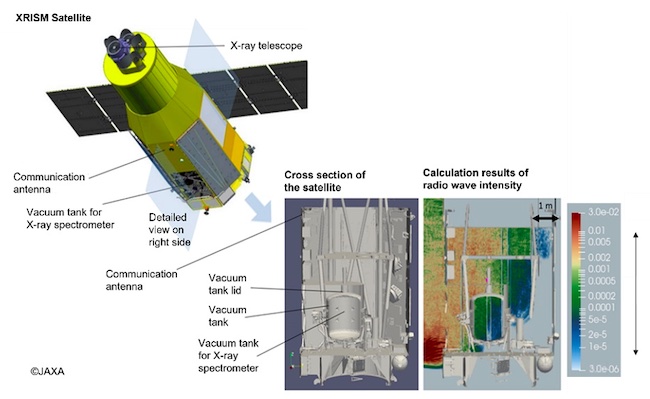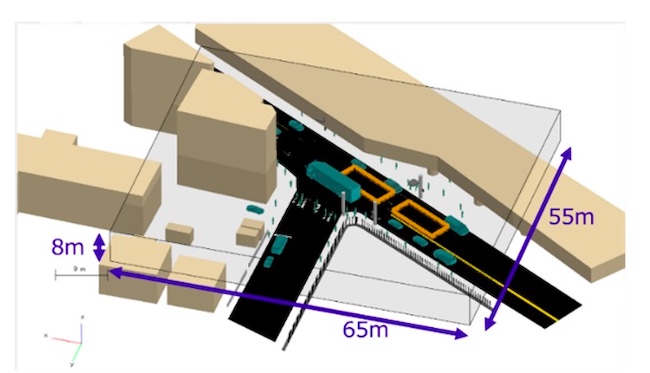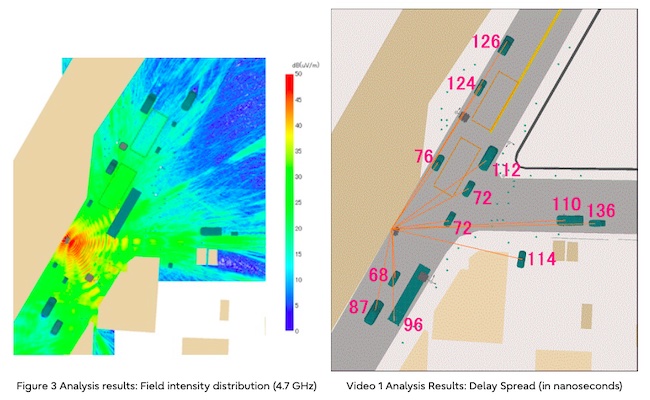
TOKYO, Jul 21, 2022 - (JCN Newswire) - Fujitsu today announced that it conducted successful large-scale electromagnetic wave simulations for a series of use cases in different industries using a cloud-based application for the supercomputer Fugaku(1).
 |
 |
 |
Fujitsu envisions that this new analysis solution will help address issues related to electromagnetic interference between electronic components and communications equipment for customers in the space and urban transportation fields. To demonstrate its capabilities, Fujitsu conducted simulations for use cases in these two fields from January to March 2022 and confirmed the effectiveness of the analysis solution as a cloud service between April and July 2022.
Through the simulations, Fujitsu demonstrated how to harness the power offered by the use of HPC resources through a cloud environment to execute precise simulations of complex and large-scale electromagnetic wave problems that could not be solved with conventional approximation algorithms(2).
Fujitsu aims to provide solutions and consulting services related to electromagnetic compatibility testing by leveraging the solution's high-precision electromagnetic wave analysis capabilities as part of Fujitsu's Computing as a Service (Below, CaaS) portfolio by the end of FY 2023 in Japan. Fujitsu is further promoting "Sustainable Manufacturing" to achieve growth through the coexistence of people and the earth as one of its key focus areas under its global business brand, Fujitsu Uvance.
Background
Electromagnetic interference between electronic components and communications equipment represents an ongoing challenge for manufacturers in a wide range of areas, including electronic equipment, automobiles, and space equipment, and demand for electromagnetic analysis solutions to evaluate electromagnetic compatibility is increasing.
Accurate simulations of complex and large-scale electromagnetic wave interference problems require computing power, and users without access to an HPC environment need to perform simulations using conventional approximation algorithms that offer only limited analysis accuracy.
Fujitsu plans to provide its electromagnetic wave analysis solution to address this challenge. The solution, available as a cloud-based application, relies on the FDTD method(3) to obtain accurate outcomes and will allow users from a wide range of industries to easily access Fujitsu's advanced computing technologies.
To verify the effectiveness of its solution as a new cloud-service, Fujitsu conducted large-scale electromagnetic wave simulations in the following two areas.
Outline of the verification tests
1. Quantitative evaluation of electromagnetic interference problems in latest X-ray space telescopes
(Case study by JAXA Institute of Space and Astronautical Science)
The Japan Aerospace Exploration Agency (JAXA) utilized Fujitsu's wave analysis solution to conduct large-scale electromagnetic wave simulations evaluating the radio wave intensity in the X-ray spectrometer(4) of JAXA's X-ray imaging satellite XRISM(5). Utilizing Fujitsu's solution, JAXA was able to generate an experiment environment that simulates observation conditions as in outer space and conducted evaluations that could not be performed with traditional computing methods(6).
As a result, JAXA successfully confirmed that the radio wave intensity in XRISM's X-ray spectrometer is at a level that does not affect the observation performance of the satellite even on orbit.
Details of the simulations:
- Analysis target: X-ray spectroscopic imaging satellite XRISM
- Analysis scale: up to 193.5 billion grids
- Analysis time: 3 hours
Comment from Masahiro Tsujimoto, Associate Professor, JAXA Institute of Space and Astronautical Science:
"High-frequency simulations using CAD models of all satellites, which have been difficult to perform with traditional computing methods, can be performed with a single solution now thanks to Fujitsu. This represents a major technical advance in satellite design. In the XRISM satellite project, the results of this simulation played an important role in quantitatively evaluating unverified risks and confirming the validity of the design."
2. Evaluation of communication quality of roadside-to-vehicle communication using 5G to contribute to safer traffic and accident prevention in urban areas
Fujitsu conducted large-scale electromagnetic wave simulations utilizing its wave analysis solution to evaluate roadside-to-vehicle (high-speed 5G) communication quality between transmitters installed at intersections and receivers installed in vehicles. In the simulations, Fujitsu also observed the effect of obstacles including surrounding buildings, roadside objects, and other vehicles in urban areas on communications quality(7). Fujitsu further directly calculated the strength and delay spread(8) of radio waves received by each vehicle's receiving antenna from transmitters installed at intersections using FDTD method simulations to achieve exact communication quality evaluation.
As a result, Fujitsu successfully conducted electromagnetic wave simulations analyzing a large urban area model taking into account complex wavelength orders(9) and proved that simulations conducted with its wave analysis solution can deliver accurate results that incorporate the effect of interference caused by complex obstacles in urban areas.
Details of the simulations:
- Analysis target: Intersection area city model including detailed model of roads and surrounding objects (model of the crossing in front of Musashinakahara station of JR Nambu Line in Nakahara-ku, Kawasaki City, Kanagawa Prefecture, Japan)
- Analysis size: 1 trillion grids
- Analysis time: Approximately 3 hours
Acknowledgements
The analyses mentioned in this release were conducted as part of the "Research for an environment to run scientific simulation software on Fugaku," a collaborative research project for a trial cloud-like use service using the computational resources of the supercomputer Fugaku, with computing resources provided by the RIKEN Center for Computational Science. (Project #: ra010012).
(1) Supercomputer Fugaku :
A computer installed at RIKEN as a successor to "K computer". From June 2020 to November 2021, Fugaku ranked first for four consecutive years in four of the major high-performance computer rankings. Fugaku was made available for shared use staring March 9, 2021.
(2) Approximation algorithms :
A method used to efficiently obtain the best possible solution in a realistic time for a problem for which it is difficult to obtain an exact solution. However, approximation is performed under a certain condition constraint, and a calculation result close to an exact solution can be obtained only when the condition constraint is satisfied. If not, an accurate calculation result cannot be obtained.
(3) FDTD method :
"Finite-Difference Time-Domain Method," a method for calculating the behavior of electromagnetic waves using a computer. An exact solution of Maxwell's equations in time and space by the finite difference method.
(4) X-ray spectrometer :
A device that detects electromagnetic waves in the X-ray region by decomposing them for each wavelength.
(5) X-ray imaging satellite XRISM :
X-Ray Imaging and Spectroscopy Mission. JAXA's seventh X-ray astronomy satellite project launched in 2018 with the cooperation of NASA and ESA. The XRISM, which is 5 to 6 meters long and has an 8-plane cylindrical shape, is equipped with an X-ray imager with a wide field of view and an X-ray spectrometer with the world's best spectroscopic performance cooled at extremely low temperatures.
(6) The X-ray spectroscopic imaging satellite XRISM, which is scheduled to be launched in fiscal 2022, is equipped with an X-ray imager with a wide field of view and an X-ray spectrometer cooled to a very low temperature. Since X-ray spectrometers are highly sensitivity towards even small energy inputs, it is necessary to minimize the effect of noise on X-ray spectrometers caused by signals other than celestial bodies, especially communication radio waves with the ground, so as not to affect the observation performance of celestial bodies. Normally, risks related to electromagnetic interference are verified by satellite tests before launch, but since X-ray spectrometers cooled to very low temperatures must be kept in a vacuum chamber and cannot be opened on the ground due to impacts of the atmosphere, the same observation conditions as in outer space cannot be realized in experiments on the ground, and sufficient verification has not been possible until now. To address this issue, JAXA utilized Fujitsu's wave analysis solution to conduct large-scale electromagnetic wave simulations in which the vacuum tank cover was opened based on data modeling of the complex and detailed structure of the satellite.
(7) Communication quality of vehicle-to-vehicle and roadside-to-vehicle communication in urban space is affected not only by communication distance but also by surrounding buildings, roadside objects, and other vehicles. To realize stable, high-speed 5G communications, it is important to evaluate communication quality as these effects increase along with a higher communication speed. Analysis of communication quality proved to be difficult until now as approximation algorithms do not support evaluation of the effects of complex buildings, large objects and other obstacles.
(8) Delay spread :
An index that affects the error rate in digital communication. The larger the value, the more likely the communication throughput speed is to decrease.
(9) Wavelength order :
A length close to the wavelength of electromagnetic waves (for example, at 4.7 GHz, about 6.4 centimeters). If the shape of the object has a complexity of less than this length, an approximate solution cannot be used in electromagnetic wave simulation, but must be solved by an exact solution such as the FDTD method featured by Fujitsu's analysis solution.
About Fujitsu
Fujitsu's purpose is to make the world more sustainable by building trust in society through innovation. As the digital transformation partner of choice for customers in over 100 countries, our 124,000 employees work to resolve some of the greatest challenges facing humanity. Our range of services and solutions draw on five key technologies: Computing, Networks, AI, Data & Security, and Converging Technologies, which we bring together to deliver sustainability transformation. Fujitsu Limited (TSE:6702) reported consolidated revenues of 3.6 trillion yen (US$32 billion) for the fiscal year ended March 31, 2022 and remains the top digital services company in Japan by market share. Find out more: www.fujitsu.com.
Copyright 2022 JCN Newswire. All rights reserved. www.jcnnewswire.com













